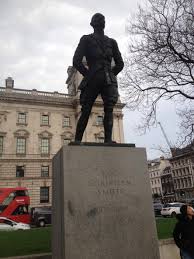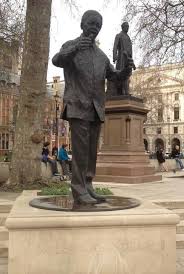by Sergen Bahceci
It seems that the debate on Cecil Rhodes’ legacy in particular and the legacy left by the British Empire in former colonies in general, has now come to an end; the University of Oxford has very recently declared that the statue will remain (The Guardian 2016). The fiery debate, initiated by Oxford students in the “Rhodes Must Fall” campaign has attracted a great deal of popular attention. Public figures as different as Naomi Wolf and Harry Mount have rallied together to plea against the statue’s removal, accusing the students of “suppressing free speech” and of having a “hypersensitive” and “unsophisticated” attitude to the world (Wolf 2016; Mount 2016).
By construing the issue as one of “free speech vs. censorship” and arguing against the removal of the statue, these commentators have been arguing for the continuation of a very particular type of statement. A statue does something greater than being a passive reminder of the person or the event which it seeks to represent; this, in the words of American philosopher Arthur Danto, would rather be the function of a “memorial” representing a past loss (Danto 1985). The statue of Cecil Rhodes standing high above the entrance of the Oriel College not a “memorial” but rather a “monument” that “commemorates the memorable and embody the myths of beginnings”. In this case, the “beginnings” being that of the Rhodes scholarship and perhaps, the heydays of the Empire.
In demanding the removal of the statue, the students were arguing for the abandonment of this particular celebration and thus, they were essentially opening up the present understandings of the past for contestation. Indeed, as Edward Said tells us, such debates are most often animated by “not only disagreement about what happened in the past and what the past was, but uncertainty about whether the past really is past, over and concluded, or whether it continues, albeit in different forms” (Said 1993:1). Silencing the debate on Rhodes inevitably results in the continuation of the current consensus on what the “past” was and indeed, whether the “past” has actually passed.
Standing in the midst of the Supreme Court, the Palace of Westminster and the Westminster Abbey, the Parliament Square is an “exhibition” of sovereignty and statehood and is this an excellent space to study in order to have insights into that consensus. In addition to its large green space that hosts London’s important political protests, the Parliament Square is also home of some dozen statues (London Assembly 2016).
Former Prime Ministers comprise the first category of figures in the Square; we have Edward Smith-Stanley (1799-1869), Henry John Temple (1774-1865), Sir Robert Peel (1788-1850), Benjamin Disraeli (1804-1881), who were all PMs at different points in the 19th century, David Lloyd George (1863-1945), Winston Churchill (1874-1965), who led Britain both in the World War I and World War II respectively. The statues of these figures were all erected a few decades after their respective deaths. We can also put the statue of Jan Smuts (1870-1950), the PM of South Africa on a few occasions and a member of Churchill’s war cabinet, within this group.
As demonstrated by the sketch above, these political figures are spread around the edges of the square. They face either the Palace or the Westminster Abbey and stand upon columns that has their names engraved on them (the column of Edward Smith-Stanley also has a mural of the Oxford University). They are dressed in their iconic costumes, a long trench coat in the case of Churchill, and stand well above the ground, having a pressing presence on the observers standing nearby (see pictures below for a sample).
In the midst of these monumental figures, two other statues have been erected in the last couple of years. In 2007, Nelson Mandela (1918-2013), anti-Apartheid fighter and the first post-Apartheid leader of South Africa, saw his own statue unveiled at the south-western corner of the Square. Another anti-colonial figure, Mahatma Gandhi (1869-1948), came to accompany him only last year.
The presence of these two figures in the same space with the former group poses an interesting puzzle: if statues such as these are meant to be celebrations of past greatness, how can “we” celebrate Gandhi and Churchill and Smuts and Mandela at the same time and moreover, in the same place? After all, Churchill is not known for holding Gandhi or the Indians in high regard (Hari 2010), and Nelson Mandela fought to replace a certain legacy held intact for a long time by Jan Smuts.
The contradictions that are associated with the co-presence of these figures haven’t really caught much public attention. However, a brief look into the features of the statues of Gandhi and Mandela can tell us something about the current “cultural balance of power”, as Clifford Geertz once termed the “equilibrium” of such opposing positions (Geertz 1971), in contemporary Britain. As pictures below indicate, the statues of Mandela and Gandhi are much smaller than the statues of the Imperial Prime Ministers. Moreover, they are not in harmony with the pattern that the earlier statues have followed – spread around the edges of the square facing either the Palace or the Abbey. The statue of Mandela occupies a particularly odd location and posture, gazing towards neither the Palace nor the Abbey.
Source: Author's own photos
We should not forget that the Parliament Square is not an ordinary, private space and these statues were not erected randomly. The Square and the statues as they stand “institutionalise” the confusion Britain is facing in relation to its past and its present. The imperial past, deemed to be “history”, represented by the towering figures standing above the columns still watch over Britain’s traditional political and spiritual centres. The recent statues, erected in order to recognise its “multicultural” present, stand at the mercy of that past; they seem like half-hearted attempts at repenting over crimes which we are not really sure whether have been committed.
Bibliography
Danto, Arthur. (1985). “The Vietnam Veterans Memorial”, The Nation, pp. 152-155.
Geertz, Clifford. (1971). Islam Observed: Religious Development in Morocco and Indonesia. Chicago: The University of Chicago Press.
Hari, Johann. (2010). “Not his finest hour: The dark side of Winston Churchill”, http://www.independent.co.uk/news/uk/politics/not-his-finest-hour-the-dark-side-of-winston-churchill-2118317.html, [accessed 01/06/2016].
London, Assembly. (2016). “Parliament Square Garden”, https://www.london.gov.uk/about-us/our-building-and-squares/parliament-square-garden, [accessed 1/06/2016].
Mount, Harry. (2016). “Finally! Oriel College should have stood up to Rhodes Must Fall long ago”, http://www.telegraph.co.uk/education/universityeducation/12129261/Finally-Oriel-College-should-have-stood-up-to-Rhodes-Must-Fall-long-ago.html, [accessed 1/06/2016].
Said, Edward. (1993). Culture and Imperialism. London: Vintage Books.
The Guardian. (2016). “Cecil Rhodes statue to remain at Oxford after ‘overwhelming support’”, http://www.theguardian.com/education/2016/jan/28/cecil-rhodes-statue-will-not-be-removed–oxford-university, [accessed 1/06/2016].
Wolf, Naomi. (2016). “Felling Rhodes’ statue is stupid, says Wolf”, http://www.theaustralian.com.au/news/world/the-times/felling-rhodes-statue-is-stupid-says-wolf/news-story/a6aa166ed448f4b2060de2d02198572d, [accessed 1/06/2016].
About the author: Sergen holds an MRes in Politics and International Relations from the University of Reading, and is currently studying for an MSc in Social Anthropology at the LSE.






